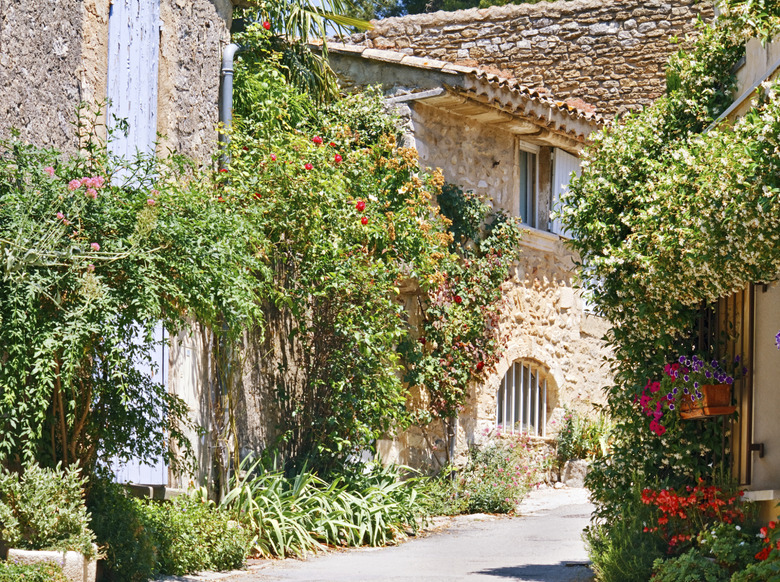Plants For A Spanish-Style Garden
Spanish garden design has heavily influenced landscaping in Mediterranean climates around the world. It is particularly well-suited to warm, dry locations because most plants grown in Spanish-style gardens are drought resistant. Silvery green foliage is a common feature in these gardens, and edible plants are frequently grown as well. The overall style is relaxed, and it pairs well with both modern and classic architecture styles. Features in a Spanish-style garden include terraces, fountains, courtyards, fountains and reflecting pools, with symmetry being a main element.
Step 1
Fruit trees are a common element in Spanish-style gardening. They provide shade and attractive foliage, as well as edible fruits. Citrus (Citrus spp.) and fig trees (Ficus spp.) both thrive in the well-drained soil and warm climates typically associated with Spanish landscaping. Citrus trees are hardy in U.S. Department of Agriculture plant hardiness zones 9 through 11. One of several fig varieties that will work in Spanish-style gardens is the "Peter's Honey" fig (Ficus carica "Peter's Honey"), which is hardy in USDA zones 7 through 9. Figs are invasive in some locations.
Step 2
Step 3
- Fruit trees are a common element in Spanish-style gardening.
Drought-Tolerant Shrubs
Step 1
Several shrubs lend themselves well to Spanish garden style and thrive in hot, dry conditions. Junipers, including the "Blue Pacific" shore juniper (Juniperus conferta "Blue Pacific," USDA zones 5 to 9), add evergreen interest. This cultivar has a low, spreading growth habit and can be used as a ground cover, growing 1 foot tall and 6 to 7 feet wide. The "Little Ollie" variety of dwarf olive (Olea europaea "Montra," USDA zones 8 to 11) has silvery foliage and a Mediterranean look. It is a non-fruiting olive with a compact growth habit and a mature size of 4 to 6 feet tall and wide. Olive trees are invasive in some locations.
Step 2
Mediterranean Herbs
Step 1
The Mediterranean region is native to many varieties of herbs, and they often appear in Spanish-style gardens. Rosemary (Rosmarinus officinalis) has the silvery-green leaves common in Mediterranean plants; it is hardy in USDA zones 7 through 11, and can be grown as an annual in cooler zones. Fennel (Foeniculum vulgare) is an annual herb that prefers dry soil, and will self-sow in USDA zones 4 through 10 if the flower heads are not removed. Oregano (Origanum vulgare, USDA zones 4 through 9) and sage (Salvia officinalis, USDA zones 5 through 9) prefer well-draining soil but need supplemental watering in dry locations.
Step 2
- Several shrubs lend themselves well to Spanish garden style and thrive in hot, dry conditions.
- Rosemary (Rosmarinus officinalis) has the silvery-green leaves common in Mediterranean plants; it is hardy in USDA zones 7 through 11, and can be grown as an annual in cooler zones.
Flowering Plants
Step 1
If you want to add showy flowers to a Spanish-style garden, look for varieties that are drought-resistant with a tropical or Mediterranean look. Hazel Spanish lavender (Lavandula stoechas "Larkman Hazel," USDA zones 7 through 9) is a good example. It is highly tolerant of drought and blooms with showy purple flowers in the spring and fall. Yucca plants are another good choice. Varieties like Golden Sword yucca (Yucca filamentosa "Golden Sword," USDA zones 4 to 9) have attractive foliage and showy flowers. This yucca blooms white in the spring, with flower stalks reaching up to 6 feet tall.
References
- Landscaping Network: Spanish Landscaping Ideas
- Landscape Design Advisor: Uncover the Hidden Delights of Mediterranean Landscape Design
- University of Florida: Mediterranean Gardens
- U.S. Forest Service Department of Agriculture: Citrus spp.
- Monrovia: Peter's Honey Fig
- Monrovia: Blue Pacific Shore Juniper
- Monrovia: Little Ollie Dwarf Olive
- Monrovia: Hazel Spanish Lavender
- Monrovia: Golden Sword Yucca
